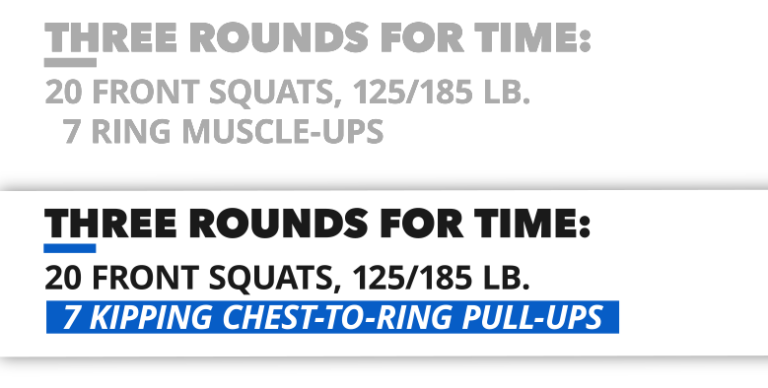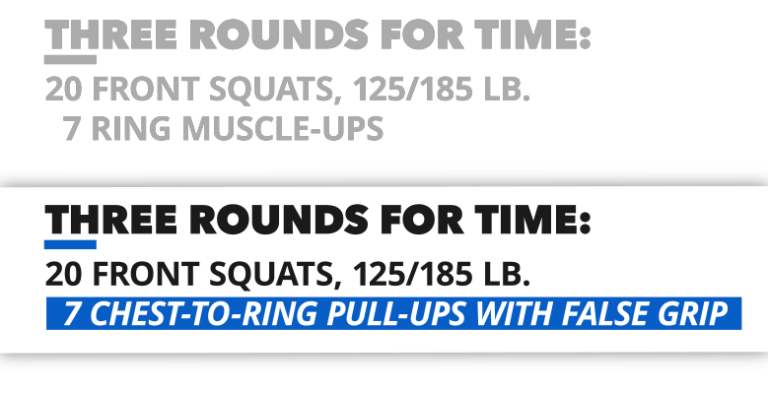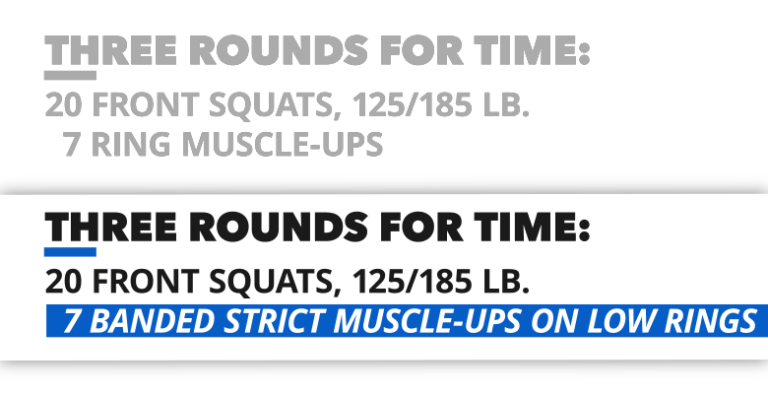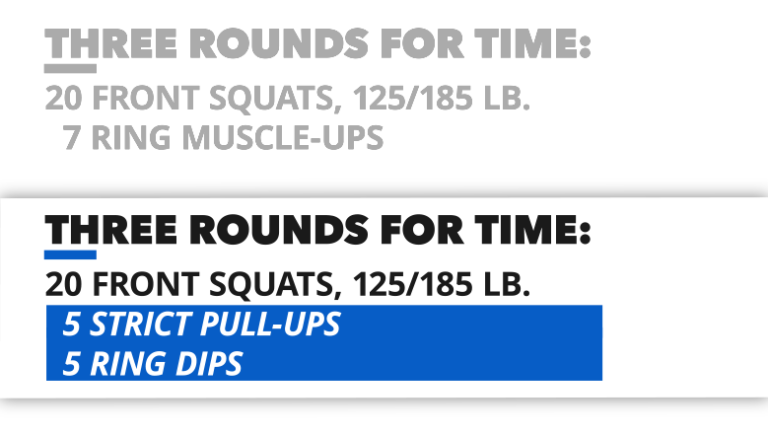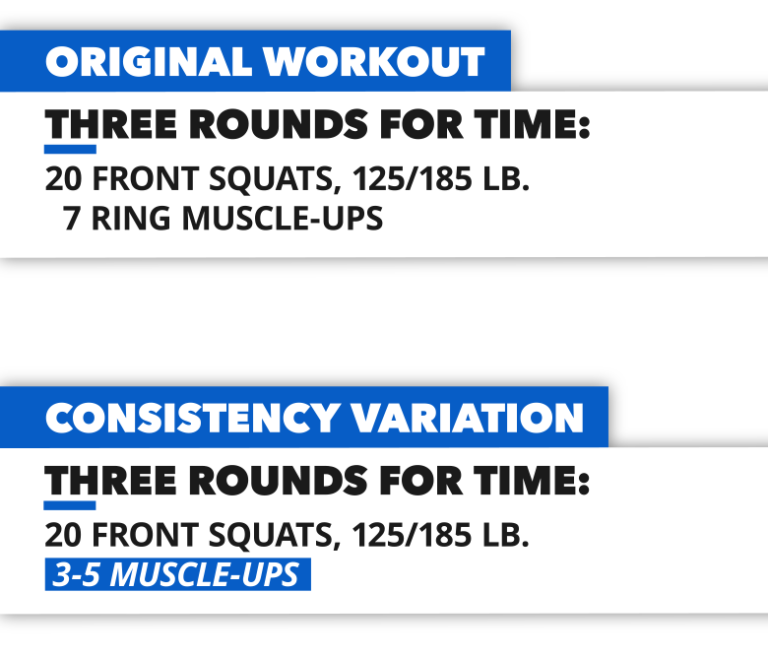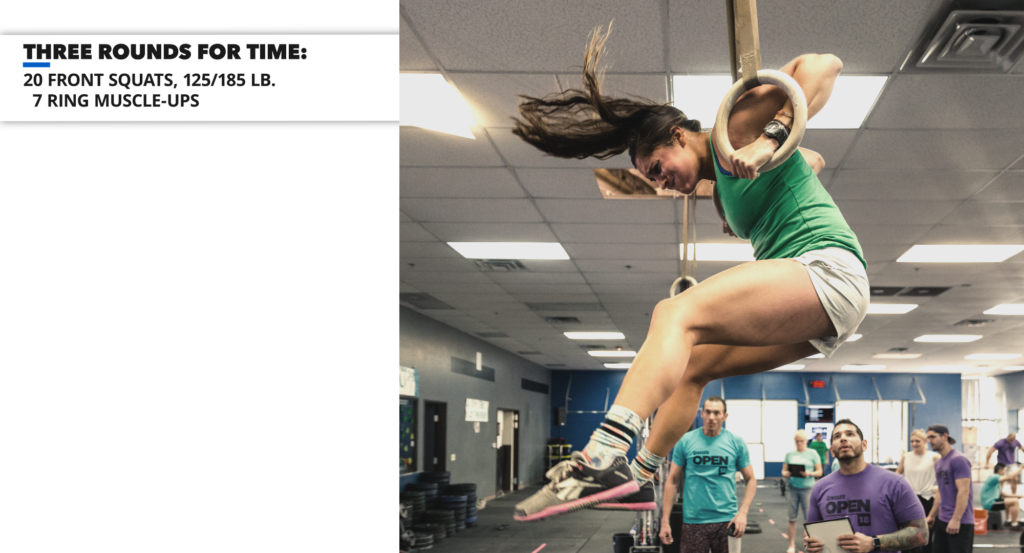In the previous installment of this two-part series, we discussed the application of mechanics, consistency, and intensity in relation to learning the muscle-up. In this installment, we will expand on that application and explore options for a group session involving athletes with a range of skill levels.
Let’s begin with the warm-up. In a properly structured warm-up, you can work with athletes of all levels along the mechanics-consistency-intensity spectrum.
Consider the following workout:
Specific Warm-Up: Muscle-Up
Athletes at all levels will benefit from each portion of this warm-up.
Assign athletes to partners. Partner 1 will complete the first movement while partner 2 rests. Then the two will switch. Continue through the movements in each section.
Part A: Strength
2 rounds of:
- 3 strict pull-ups – Scale as needed to partner-assisted strict pull-ups.
- 10-second ring support hold – Scale as needed to partner-assisted hold.
- 3 strict ring dips – Scale as needed to ring dip negative with a jump to support.
Part B: Technique On Low Rings
1 round of:
- 5 false-grip strict ring rows – Use legs as needed to modify difficulty.
- 5 false-grip strict ring rows + 2-second pause + transition to bottom of dip – Keep feet on the ground and use the legs to modify difficulty.
- 5 low ring transitions with feet on the ground.
- 3 strict muscle-ups with banded assistance – Scale to low ring transitions if the athlete isn’t ready for this step.
- 1 strict muscle-up from seated – Scale to a previous exercise in the progression if necessary.
Part C: Practice On High Rings
(If athletes are not ready for this, remain on low rings)
1 round of:
- 5 kip swings
- 5 kipping chest-to-ring pull-ups – May scale to kip swings.
- 1-2 muscle-up attempts – Allow athletes who have the requisite strength base and have acquired low ring transition skills in previous progressions to attempt a strict muscle-up here. Scale others to a previous low ring progression.
Once the warm-up is complete, match your athletes along the mechanics-consistency-intensity spectrum. Each category will have a different goal designed to challenge the athlete’s current level of ability.
Workout Scaling: Mechanics Stage
This first stage is useful for athletes who have not yet completed a muscle-up due to a lack of requisite strength or undeveloped technique. In each circumstance, the trainer should be ready to offer a variation that develops the athlete’s weakness.
Goals:
1) Build baseline pulling/pressing capacity.
2) Practice skill components of the muscle-up.
Option 1:
Focus on the chest-to-ring pull-up needed during the muscle-up.
Option 2:
Focus on the pull-up needed during the muscle-up AND the false grip.
Option 3:
Focus on the transition.
Option 4:
Focus on the requisite pulling and pressing capacity.
Consistency Stage
This level of scaling is useful for athletes who have completed muscle-ups in practice but may not have experience performing them during a workout. It is also appropriate for an athlete who has performed a few workouts with muscle-ups but cannot perform more than a few reps at a time.
Goal:
Practice muscle-ups within the workout. Focus on maintaining sound mechanics while working a higher level of intensity.
In the workout brief, discuss rest and repetition strategies to reduce fatigue and the chance of failure. Mandating a certain number of repetitions and then a required rest period is one such strategy. For example, you could say, “Do three singles each round and rest about 30 seconds between reps,” or, “Start each round with two consecutive reps and then do the remaining two reps as singles.”
Technical proficiency will likely begin to break down in the middle of this workout. This is the best opportunity for you to coach! For example, if you see an athlete beginning to transition early, coach them to wait until their body is closer to the rings before beginning their transition. If you see an athlete with an overextended spine in the press out of the ring dip, coach bringing the legs forward and squeezing the abs after the transition. Use short, actionable cues to improve technique. If you do a good job coaching, the last rep should look close to the first rep of the workout, or technique may even improve from the first rep to the last rep.
Intensity Stage
Athletes who can focus on intensity are those who are consistent and comfortable approaching workouts including muscle-ups. The trainer is no longer providing modifications but instead offering strategies to get the athlete through the workout quickly and effectively.
Goal:
Increase power output. Complete the workout as written.
The first consideration is how to approach the muscle-ups. Trainers can offer rep schemes based on the athlete’s proficiency with the muscle-up. For example, a very advanced athlete may be challenged with attempting unbroken sets on every round. An athlete who is not quite ready for such large sets may be encouraged to break up the sets into 3/2/2 reps every round, focusing on minimizing the rest between sets while keeping technique smooth and efficient.
The second approach is to encourage athletes to reduce the number of sets needed to complete the front squats and focus on increasing the speed of their reps. The goal here is to challenge the less technical aspects of the workout and reduce the rest intervals between sets of muscle-ups. This will increase the average power output across the entire workout.
Of course, consistency still applies here. Even advanced athletes will experience a breakdown in their technique. Trainers must continue to correct movement at faster and faster speeds while keeping an eye out for more subtle technical deviations. Continue reinforcing the mechanics and consistency.
Final Thoughts
Factors such as how frequently muscle-ups are programmed will have a direct impact on the speed of an athlete’s development. In practice, a new skill (in this case the muscle-up) should be programmed with enough frequency that athletes are exposed to the stimulus on a regular basis. A general recommendation is to expose your athletes to the movement in at least two workouts per month alongside another one to three exposures during skill work in the warm-up, cool-down, or skill practice portions of the class.
Following the charter of mechanics, consistency, and then intensity helps maximize both the safety and results of our athletes. While these are useful general guidelines, remember that all athletes have their own unique set of circumstances. The more attention and coaching you can give to your athletes during class, the closer you can get them to working at their appropriate and most beneficial individual threshold.

